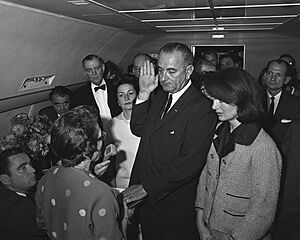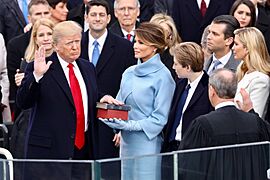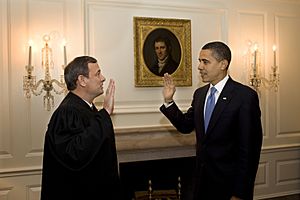Oath of office of the president of the United States facts for kids
The oath of office of the president of the United States is a special promise the president of the United States makes when they start their job. This promise is written in the United States Constitution, in a part called Article II, Section One, Clause 8. A new president must take this oath before they can use any of their official powers or duties.
This specific oath is unique because it's the only one in the Constitution that gives the exact words to be spoken. Other parts of the Constitution mention oaths, but they don't list the words. The presidential oath is a strong promise to "preserve, protect and defend the Constitution of the United States." This means the president promises to do their best to keep the Constitution safe and follow its rules.
Contents
What the Oath Says
Before he enter on the Execution of his Office, he shall take the following Oath or Affirmation:—
"I do solemnly swear (or affirm) that I will faithfully execute the Office of President of the United States, and will to the best of my ability, preserve, protect and defend the Constitution of the United States."
The Swearing-In Ceremony

A new president starts their four-year term at noon on January 20, after the election. Traditionally, they take the oath during a public event called an inauguration on that day. Before 1937, the president's term used to start on March 4.
If January 20 falls on a Sunday, the president usually takes the oath privately that day. Then, they repeat the oath in a public ceremony the next day, on January 21.
Sometimes, a vice president becomes president if the current president dies or resigns. In these cases, the oath is given very quickly. This makes sure the country's leadership continues without any breaks.
Who Gives the Oath?

The Constitution doesn't say who must give the presidential oath. However, since John Adams's time, the Chief Justice of the Supreme Court has usually done it.
There have been a few exceptions:
- George Washington took his first oath in 1789 from Robert Livingston, who was a judge in New York.
- When Zachary Taylor died, Millard Fillmore became president in 1850. The oath was given by William Cranch, a chief judge.
- After Warren Harding died, Calvin Coolidge was sworn in by his own father, John Calvin Coolidge Sr., who was a notary public (someone who can legally witness signatures).
- Sarah T. Hughes, a federal judge, gave the oath to Lyndon B. Johnson on Air Force One after John F. Kennedy's assassination in 1963. She is the only woman to have given the oath.
Overall, many different people have given the oath. This includes 15 chief justices, one associate justice, four federal judges, two New York state judges, and one notary public.
Choosing to "Affirm"
The Constitution allows a president to "affirm" instead of "swear." This option might be for certain Christians, like Quakers, who believe they should not "swear" oaths.
Franklin Pierce is the only president known to have used "affirm" instead of "swear." While Herbert Hoover was a Quaker and is sometimes thought to have affirmed, a newsreel shows he actually "solemnly swore." Richard Nixon, also a Quaker, chose to swear.
How the Oath is Given
The way the oath is given has changed over time.
In the past, the person giving the oath would ask a question, like, "Do you, George Washington, solemnly swear...?" The president would then reply, "I do" or "I swear." This was common until the early 1900s. For example, in 1929, Chief Justice William H. Taft asked Herbert Hoover, "You, Herbert Hoover, do you solemnly swear...?" and Hoover simply said, "I do."
Today, the person giving the oath says the oath phrase by phrase, and the president repeats each phrase exactly. Franklin D. Roosevelt started this modern way in 1933. By Harry S. Truman's inauguration in 1949, this repeating method was the standard.
Using Bibles

It's a tradition for presidents to raise their right hand and place their left hand on a Bible when taking the oath. In 1789, George Washington used a Bible borrowed from a Masonic lodge and kissed it afterward.
Many presidents after Washington, up to Harry S. Truman, also kissed the Bible. Some presidents, like Truman, Dwight D. Eisenhower, Richard Nixon, George H. W. Bush, and Barack Obama, have used two Bibles. Joe Biden used a large family Bible that had been in his family since 1893.
Not all presidents have used a Bible. Thomas Jefferson and Calvin Coolidge did not. Theodore Roosevelt did not use one in 1901. John Quincy Adams swore on a book of law, meaning to swear on the Constitution itself. Lyndon B. Johnson used a Roman Catholic missal (a prayer book) for his first oath on Air Force One, thinking it was a Bible. He used a Bible for his second inauguration.
Donald Trump used two Bibles for his first inauguration: one from his mother and the Lincoln Bible. These Bibles were present at his second inauguration, but he did not place his hand on them.
Adding "So Help Me God"
The phrase "So help me God" is often added to the end of the oath. While the Constitution doesn't require it for the president's oath, it is required for other U.S. judges and officers, unless they choose to "affirm." Most presidents, especially in the last century, have chosen to say "So help me God" and use a Bible.
There's a discussion about whether George Washington, the first president, added this phrase. The earliest story saying he did came out 65 years after the event. Other records from his time don't mention him saying it.
The debate is tricky because of the two ways the oath has been given. When the oath was asked as a question, the president's answer like "I will, so help me God" would complete it. For example, in 1881, Chester A. Arthur reportedly said, "I will, so help me God."
Records show that Abraham Lincoln said "So help me God" at his second inauguration in 1865. More recent research suggests presidents like William Henry Harrison (1841) and Andrew Jackson also used the phrase. Since Franklin D. Roosevelt, almost every president has said "So help me God."
Oath Mistakes

Sometimes, mistakes have happened during the oath:
- In 1909, Chief Justice Melville Fuller misquoted the oath when swearing in President William Howard Taft.
- In 1925, Chief Justice Taft (who was also a former president) made a few small errors when giving the oath to President Calvin Coolidge.
- Again in 1929, Chief Justice Taft famously mixed up some words when swearing in President Herbert Hoover. He said "preserve, maintain, and defend" instead of "preserve, protect, and defend." Taft didn't think the mistake was important, and Hoover didn't retake the oath.
- In 1945, when Harry S. Truman first became president, Chief Justice Harlan F. Stone mistakenly added a middle name to Truman's initial "S."
- In 1953 and 1957, Dwight D. Eisenhower himself misread a line, adding "the" before "President of the United States."
- In 1965, Chief Justice Earl Warren prompted Lyndon B. Johnson to say "the Office of the Presidency" instead of "the Office of President."
- In 1973, President Richard Nixon added an extra "and" to a line.
- In 2009, Chief Justice John Roberts incorrectly recited part of the oath to Barack Obama. Obama paused, and Roberts tried to correct himself, but it was still a bit off. Because of this, the oath was given again the next day at the White House to make sure it was correct.
List of Ceremonies
Since the office of President began in 1789, there have been 59 public swearing-in ceremonies for new four-year terms. There have also been nine additional ceremonies when a vice president became president because the current president died or resigned.
As of 2025, the presidential oath has been taken 76 times by 45 different people. This number is higher than the number of presidents because:
- A president takes the oath at the start of each term they serve.
- Five presidents took the oath privately on a Sunday before their public ceremony.
- Three presidents repeated the oath as a precaution to avoid any future legal questions.
| Date | Type | Event | Location | Oath administered by |
|---|---|---|---|---|
| April 30, 1789 (Thursday) |
Public | First inauguration of George Washington | Balcony, Federal Hall New York, New York |
Robert Livingston Chancellor of New York |
| March 4, 1793 (Monday) |
Second inauguration of George Washington | Senate Chamber, Congress Hall Philadelphia, Pennsylvania |
William Cushing Associate Justice, U.S. Supreme Court |
|
| March 4, 1797 (Saturday) |
Inauguration of John Adams | House Chamber, Congress Hall |
Oliver Ellsworth Chief Justice of the United States |
|
| March 4, 1801 (Wednesday) |
First inauguration of Thomas Jefferson | Senate Chamber, U.S. Capitol Washington, D.C. |
John Marshall Chief Justice of the United States |
|
| March 4, 1805 (Monday) |
Second inauguration of Thomas Jefferson | Senate Chamber, U.S. Capitol |
||
| March 4, 1809 (Saturday) |
First inauguration of James Madison | House Chamber, U.S. Capitol |
||
| March 4, 1813 (Thursday) |
Second inauguration of James Madison | |||
| March 4, 1817 (Tuesday) |
First inauguration of James Monroe | Front steps, Old Brick Capitol |
||
| March 5, 1821 (Monday) |
Second inauguration of James Monroe | House Chamber, U.S. Capitol |
||
| March 4, 1825 (Friday) |
Inauguration of John Quincy Adams | |||
| March 4, 1829 (Wednesday) |
First inauguration of Andrew Jackson | East Portico, U.S. Capitol |
||
| March 4, 1833 (Monday) |
Second inauguration of Andrew Jackson | House Chamber, U.S. Capitol |
||
| March 4, 1837 (Saturday) |
Inauguration of Martin Van Buren | East Portico, U.S. Capitol |
Roger B. Taney Chief Justice of the United States |
|
| March 4, 1841 (Thursday) |
Inauguration of William Henry Harrison | |||
| April 6, 1841 (Tuesday) |
Private | Inauguration of John Tyler | Brown's Indian Queen Hotel, Washington, D.C. |
William Cranch Chief Judge, U.S. Circuit Court of the District of Columbia |
| March 4, 1845 (Tuesday) |
Public | Inauguration of James K. Polk | East Portico, U.S. Capitol |
Roger B. Taney Chief Justice |
| March 5, 1849 (Monday) |
Inauguration of Zachary Taylor | |||
| July 10, 1850 (Wednesday) |
Inauguration of Millard Fillmore | House Chamber, U.S. Capitol |
William Cranch Circuit Court Judge |
|
| March 4, 1853 (Friday) |
Inauguration of Franklin Pierce | East Portico, U.S. Capitol |
Roger B. Taney Chief Justice |
|
| March 4, 1857 (Wednesday) |
Inauguration of James Buchanan | |||
| March 4, 1861 (Monday) |
First inauguration of Abraham Lincoln | |||
| March 4, 1865 (Saturday) |
Second inauguration of Abraham Lincoln | Salmon P. Chase Chief Justice of the United States |
||
| April 15, 1865 (Saturday) |
Private | Inauguration of Andrew Johnson | Kirkwood House Hotel, Washington, D.C. |
|
| March 4, 1869 (Thursday) |
Public | First inauguration of Ulysses S. Grant | East Portico, U.S. Capitol |
|
| March 4, 1873 (Tuesday) |
Second inauguration of Ulysses S. Grant | |||
| March 3, 1877 (Saturday) |
Private | Inauguration of Rutherford B. Hayes | Red Room, White House |
Morrison Waite Chief Justice of the United States |
| March 5, 1877 (Monday) |
Public | East Portico, U.S. Capitol |
||
| March 4, 1881 (Friday) |
Inauguration of James A. Garfield | |||
| September 20, 1881 (Tuesday) |
Private | Inauguration of Chester A. Arthur | Chester A. Arthur Home, New York, New York |
John R. Brady Justice of the New York Supreme Court |
| September 22, 1881 (Thursday) |
Public | The Vice President's Room, U.S. Capitol |
Morrison Waite Chief Justice |
|
| March 4, 1885 (Wednesday) |
First inauguration of Grover Cleveland | East Portico, U.S. Capitol |
||
| March 4, 1889 (Monday) |
Inauguration of Benjamin Harrison | Melville Fuller Chief Justice of the United States |
||
| March 4, 1893 (Saturday) |
Second inauguration of Grover Cleveland | |||
| March 4, 1897 (Thursday) |
First inauguration of William McKinley | Front of original Senate Wing U.S. Capitol |
||
| March 4, 1901 (Monday) |
Second inauguration of William McKinley | East Portico, U.S. Capitol |
||
| September 14, 1901 (Saturday) |
Private | First inauguration of Theodore Roosevelt | Ansley Wilcox Home, Buffalo, New York |
John R. Hazel Judge, U.S. District Court for the Western District of New York |
| March 4, 1905 (Saturday) |
Public | Second inauguration of Theodore Roosevelt | East Portico, U.S. Capitol |
Melville Fuller Chief Justice |
| March 4, 1909 (Thursday) |
Inauguration of William Howard Taft | Senate Chamber, U.S. Capitol |
||
| March 4, 1913 (Tuesday) |
First inauguration of Woodrow Wilson | East Portico, U.S. Capitol |
Edward D. White Chief Justice of the United States |
|
| March 4, 1917 (Sunday) |
Private | Second inauguration of Woodrow Wilson | The President's Room, U.S. Capitol |
|
| March 5, 1917 (Monday) |
Public | East Portico, U.S. Capitol |
||
| March 4, 1921 (Friday) |
Inauguration of Warren G. Harding | |||
| August 3, 1923 (Friday) |
Private | First inauguration of Calvin Coolidge | Coolidge Homestead, Plymouth Notch, Vermont |
John Calvin Coolidge Vermont Justice of the peace |
| August 21, 1923 (Tuesday) |
Willard Hotel Washington, D.C. |
Adolph A. Hoehling Jr. Judge, U.S. District Court for the District of Columbia |
||
| March 4, 1925 (Wednesday) |
Public | Second inauguration of Calvin Coolidge | East Portico, U.S. Capitol |
William H. Taft Chief Justice of the United States |
| March 4, 1929 (Monday) |
Inauguration of Herbert Hoover | |||
| March 4, 1933 (Saturday) |
First inauguration of Franklin D. Roosevelt | Charles E. Hughes Chief Justice of the United States |
||
| January 20, 1937 (Wednesday) |
Second inauguration of Franklin D. Roosevelt | |||
| January 20, 1941 (Monday) |
Third inauguration of Franklin D. Roosevelt | |||
| January 20, 1945 (Saturday) |
Fourth inauguration of Franklin D. Roosevelt | South Portico, White House |
Harlan F. Stone Chief Justice of the United States |
|
| April 12, 1945 (Thursday) |
Private | First inauguration of Harry S. Truman | Cabinet Room, White House |
|
| January 20, 1949 (Thursday) |
Public | Second inauguration of Harry S. Truman | East Portico, U.S. Capitol |
Fred M. Vinson Chief Justice of the United States |
| January 20, 1953 (Tuesday) |
First inauguration of Dwight D. Eisenhower | |||
| January 20, 1957 (Sunday) |
Private | Second inauguration of Dwight D. Eisenhower | East Room, White House |
Earl Warren Chief Justice of the United States |
| January 21, 1957 (Monday) |
Public | East Portico, U.S. Capitol |
||
| January 20, 1961 (Friday) |
Inauguration of John F. Kennedy | |||
| November 22, 1963 (Friday) |
Private | First inauguration of Lyndon B. Johnson | Air Force One, Dallas Love Field, Dallas, Texas |
Sarah T. Hughes Judge, U.S. District Court for the Northern District of Texas |
| January 20, 1965 (Wednesday) |
Public | Second inauguration of Lyndon B. Johnson | East Portico, U.S. Capitol |
Earl Warren Chief Justice |
| January 20, 1969 (Monday) |
First inauguration of Richard Nixon | |||
| January 20, 1973 (Saturday) |
Second inauguration of Richard Nixon | Warren Burger Chief Justice of the United States |
||
| August 9, 1974 (Friday) |
Inauguration of Gerald Ford | East Room, White House |
||
| January 20, 1977 (Thursday) |
Inauguration of Jimmy Carter | East Portico, U.S. Capitol |
||
| January 20, 1981 (Tuesday) |
First inauguration of Ronald Reagan | West Front, U.S. Capitol |
||
| January 20, 1985 (Sunday) |
Private | Second inauguration of Ronald Reagan | Entrance Hall, White House |
|
| January 21, 1985 (Monday) |
Public | Rotunda, U.S. Capitol |
||
| January 20, 1989 (Friday) |
Inauguration of George H. W. Bush | West Front, U.S. Capitol |
William Rehnquist Chief Justice of the United States |
|
| January 20, 1993 (Wednesday) |
First inauguration of Bill Clinton | |||
| January 20, 1997 (Monday) |
Second inauguration of Bill Clinton | |||
| January 20, 2001 (Saturday) |
First inauguration of George W. Bush | |||
| January 20, 2005 (Thursday) |
Second inauguration of George W. Bush | |||
| January 20, 2009 (Tuesday) |
First inauguration of Barack Obama | John Roberts Chief Justice of the United States |
||
| January 21, 2009 (Wednesday) |
Private | Map Room, White House |
||
| January 20, 2013 (Sunday) |
Second inauguration of Barack Obama | Blue Room, White House |
||
| January 21, 2013 (Monday) |
Public | West Front, U.S. Capitol |
||
| January 20, 2017 (Friday) |
First inauguration of Donald Trump | |||
| January 20, 2021 (Wednesday) |
Inauguration of Joe Biden | |||
| January 20, 2025 (Monday) |
Second inauguration of Donald Trump | Rotunda, U.S. Capitol |
||
| Date | Type | Event | Location | Oath administered by |
Notes
Images for kids
Related Topics


